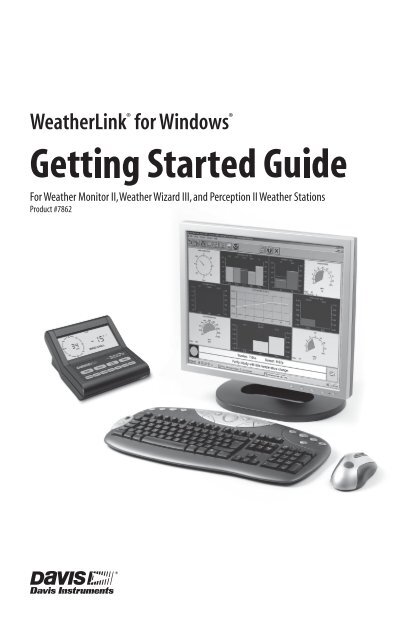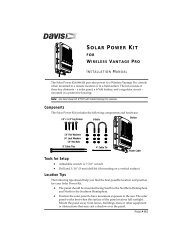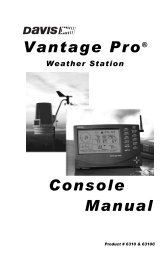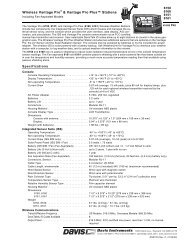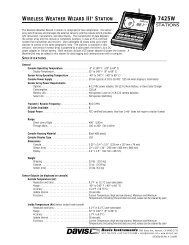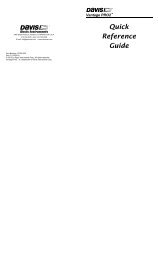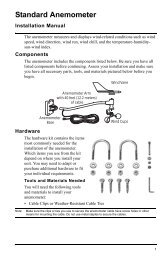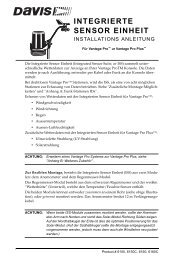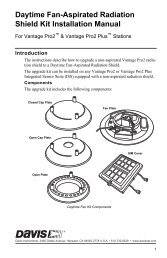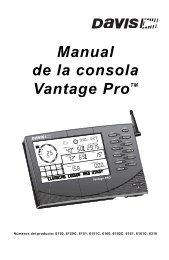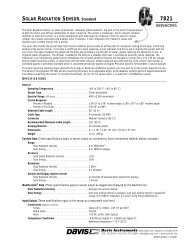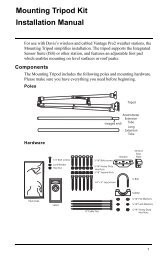WeatherLink Getting Started Guide - Davis Instruments Corp.
WeatherLink Getting Started Guide - Davis Instruments Corp.
WeatherLink Getting Started Guide - Davis Instruments Corp.
Create successful ePaper yourself
Turn your PDF publications into a flip-book with our unique Google optimized e-Paper software.
FCC Part 15 Class B Registration WarningThis equipment has been tested and found to comply with the limits for a Class B digital device, pursuant toPart 15 of the FCC Rules. These limits are designed to provide reasonable protection against harmful interferencein a residential installation. This equipment generates, uses and can radiate radio frequency energy and,if not installed and used in accordance with the instructions, may cause harmful interference to radio communications.However, there is no guarantee that interference will not occur in a particular installation. If this equipmentdoes cause harmful interference to radio or television reception, which can be determined by turning theequipment on and off, the user is encouraged to try to correct the interference by one or more of the followingmeasures:• Reorient or relocate the receiving antenna• Increase the separation between the equipment and receiver• Connect the equipment into an outlet on a circuit different from that to which the receiver is connected• Consult the dealer or an experienced radio/TV technician for help.Changes or modifications not expressly approved in writing by <strong>Davis</strong> <strong>Instruments</strong> may void the user’s authorityto operate this equipment.EC EMC ComplianceThis product complies with the essential protection requirements of the EC EMC Directive 89/336/EC.Product Number: 7862 Part Number: 7395.179<strong>WeatherLink</strong> ® for Weather Monitor II ® , Weather Wizard III ® , and Perception II ® Rev. C September 29, 2009<strong>WeatherLink</strong>, Weather Monitor II, Weather Wizard III, and Perception II are trademarks of <strong>Davis</strong> <strong>Instruments</strong><strong>Corp</strong>. Hayes is a registered trademark of Hayes Microcomputer Products, Inc. Windows is a trademark ofMicrosoft <strong>Corp</strong>oration.© 2009 <strong>Davis</strong> <strong>Instruments</strong> <strong>Corp</strong>. All rights reserved.Information in this document is subject to change without notice.3465 Diablo Avenue, Hayward, CA 94545-2778 U.S.A.510-732-9229 • Fax: 510-732-9188E-mail: info@davisnet.com • www.davisnet.com
Welcome to <strong>WeatherLink</strong>!Welcome to <strong>Davis</strong> <strong>Instruments</strong>’ <strong>WeatherLink</strong> for Windows. <strong>WeatherLink</strong>’s datalogger and software connects a personal computer to your <strong>Davis</strong> weather station,allowing you to store, view, plot, analyze, export, and print your weather data.The following <strong>Davis</strong> <strong>Instruments</strong>’ weather stations are supported: Weather MonitorII ® , Weather Wizard III ® , and Perception II ® .Contents of PackageBefore continuing, please make sure your <strong>WeatherLink</strong> package contains thefollowing listed items:• Data Logger for Monitor, Wizard and Perception• 9-pin (DB-9) PC COM Port Adapter (black) — Use the 9-pin adapter toconnect the data logger to a 9-pin serial port.Note: If you need a 25-pin adapter, contact <strong>Davis</strong> <strong>Instruments</strong> Technical Support at510-732-7814.• Loopback Connector — The loopback connector is a short piece of cablewith a phone plug at one end and a red plastic cap at the other.• <strong>WeatherLink</strong> Software CD ROMOptional AccessoriesThe following optional accessories, designed for use with <strong>WeatherLink</strong>, areavailable from your dealer or may be ordered directly from <strong>Davis</strong>.• Telephone Modem Adapter (# 7870) — For transmission of data from thedata logger using a modem.• Standard 4-Conductor Extension Cable (# 7876) — For more flexibility inthe placement of your console. Add one 40' (12 m) extension cable to extendthe distance between your station and the computer (48' (14.4 m) maximum).• USB-to-Serial Cable (# 8434) — For computers with no serial port. Allowsyou to convert the console’s serial connection to a USB interface.Hardware InstallationYou can either install <strong>WeatherLink</strong> to create a local connection between yourcomputer and weather station, or you can install <strong>WeatherLink</strong> to use a modemconnection to a remote weather station. Requirements and installation for eachtype of connection differ, and are explained separately below.1
Software InstallationLocal Connection Hardware RequirementsThe following additional hardware is required for a local connection:• Computer running Windows 2000, XP, or Vista and requires 5 MB offree disk space.Note: The .NET framework is required to run <strong>WeatherLink</strong> 5.8 or later. It is installed as part ofthe software installation if it is not already on your computer.The amount of disk space necessary depends on the archive interval.Database files containing data stored at a 30 minute archive intervalrequire approximately 132K of disk space per month of data. The file sizechanges in a linear fashion depending on the archive interval. For example,data stored at a 1–minute interval requires approximately 3.9 MB permonth while the data stored at a 2–hour interval requires approximately33 KB per month.• Windows-Compatible Display — VGA minimum. SVGA or High (16-bit) Color recommended.• One free serial port or USB Port with USB-to-Serial cable.Remote Modem Connection Hardware RequirementsIn addition to the provided hardware and the computer equipment listed above,the following hardware is required for a remote modem connection.• One external modem to connect to the data logger at the remote site.• One internal or external modem connected to your computer• Modems must be Hayes ® Compatible and able to send data at 1200 or 2400baud rate.• Telephone Modem Adapter — The Telephone Modem Adapter isspecially wired to provide the connection between the data logger and themodem. Use a # 7870 adapter.Note: See the Application Note entitled “Setting up a Remote Modem Connection” located onthe Weather Support section of the <strong>Davis</strong> website:http://www.davisnet.com/support/weather/.Software InstallationFollow the steps below to install the <strong>WeatherLink</strong> software.1. Place the <strong>WeatherLink</strong> software CD in your CD ROM drive.The install program should start automatically. If the install program doesnot start, select Run from the Start menu, type D:\SETUP (or the correctletter for your CD ROM drive), and click OK to begin the installation.2
Software InstallationA series of dialog boxes display, prompting you to complete the<strong>WeatherLink</strong> installation. The <strong>WeatherLink</strong> Setup for .NET Frameworkdialog box may display.<strong>WeatherLink</strong> 5.8 requires the Microsoft .NET Framework 2.0 to operate. Ifyour computer does not have it installed, the above dialog box displays.2. Click Accept to install the necessary components.The License Agreement dialog box displays.3
Local Connection Installation3. Review the license agreement, click I agree and click Next. The ChooseDestination Location dialog box displays.C:\<strong>WeatherLink</strong>\4. Select the default location to install <strong>WeatherLink</strong> or find another locationby clicking Browse.Note: If you are upgrading your software from a previous version, click Browse to search forthe directory or folder of the previous version of <strong>WeatherLink</strong>. This verifies that you havea previous version of <strong>WeatherLink</strong> installed and allows you to use those availabledatabase files.5. Click Next once you have selected a location. The Confirm Installationdialog box displays.6. Click Next to start the installation. The Installing <strong>WeatherLink</strong> dialogbox displays the installation progress. The Installation Successful dialogbox displays once the software installation has been completed.7. Click OK. <strong>WeatherLink</strong> has been installed successfully.Local Connection InstallationThe instructions below explain how to connect your Weather Monitor II,Weather Wizard III, or Perception II weather station directly to your computer.4
Local Connection InstallationTypical Local Connection for Original Weather Stations1. Make a note of the barometric pressure, total rainfall, and (if applicable)calibration numbers.You must remove power from the weather station console to install thedata logger. Removing power will cause these stored weather values to beerased. Use <strong>WeatherLink</strong> to reenter these values after restoring power tothe console.2. Remove the mounting base from the console.3. Remove all power from the console by removing the power adapter andbattery backup.Failure to remove power before installing the data logger may causedamage to the data logger and/or console.4. A small switch near the data logger cables controls the baud rate. Thedefault setting is 2400 baud. If you need to run at 1200 baud, change thesetting before connecting the data logger to the console.5. Connect the short data logger cable to the cable jack marked“<strong>WeatherLink</strong>” on the bottom of your weather station console.6. Restore power to the console by reattaching the power adapter and listenfor the console to emit beeps.The console should beep three times. The third beep, which should occurwithin 30 seconds, indicates that the data logger is operating correctly.After hearing the three beeps, re-install the battery backup.5
Remote Connection Installation7. Place the data logger inside themounting base.8. Reattach the mounting base to theweather station.As you do so, guide all the cablesthrough the slots on the mounting base.9. Locate a free serial port on the back ofyour computer and connect the blackDB9 adapter to the port or use theUSB-to-Serial cable to connect to a freeUSB Port.Placing Data Logger Inside Base10. Connect the long data logger cable tothe DB9 adapter connector.The cable connecting the data logger to the computer is 8' (2.4 m) long. Ifyou need to place the station console more than 8' from the computer, usethe 40' (12 m) 4-conductor extension cable (# 7876-040).Note: Do not attempt to use more than 40’ of extension cable, or the data logger may havedifficulty communicating with the computer. Do not attempt to use 4-conductor telephonecable because telephone cable will not work with the connection.Remote Connection InstallationYou can connect your computer to a remote weather station using a modem.This involves using the data logger to connect the weather station console to amodem at the remote site. Your computer can then use a modem tocommunicate to the remote weather station via a phone line.At Your Computer:1. If you don’t have a modem, install and set up an internal or externalmodem according to the instructions supplied by the manufacturer.2. Connect the modem to the phone line.At Your Weather Station Console:1. Make a note of the barometric pressure, total rainfall, and (if applicable)calibration numbers.You must remove power from the weather station to install the<strong>WeatherLink</strong> data logger, which will cause these values to be erased. Use<strong>WeatherLink</strong> to reenter these values after restoring power to the station.2. Place the external modem in a location where it can connect to both thedata logger and the phone jack. Do not turn the modem on at this time.3. Remove the mounting base from the weather station.4. Remove all power from the weather station by removing the power adapterand battery backup.6
Remote Connection InstallationFailure to remove power before installing the data logger may cause damageto the data logger and/or station.Typical Remote Installation for Original Weather Stations5. A small switch on the data logger near the cables controls the baud rate.The default setting is 2400 baud. If you need to run at 1200 baud, changethe setting before connecting the data logger to the console.6. Connect the short data logger cable to the cable jack marked “Weather-Link” on the bottom of your weather station console.7. Connect the blue Telephone Modem Adapter to the external modem.The Telephone Modem Adapter (#7870) is required to use the data loggerwith a modem. A standard DB25 connector with a gender changer will notwork.8. Connect the long data logger cable to the Telephone Modem Adapter.9. Turn the modem on.10. Restore power to the weather station console by reattaching the poweradapter and listen for the console to emit beeps.The console should beep three times. The third beep, which should occurwithin 30 seconds, indicates that the data logger is operating correctly.After hearing the three beeps, re-install the battery backup.7
Remote Modem Connection Notes11. Place the data logger inside the mountingbase.12. Reattach the mounting base to theweather station.As you do so, guide all the cablesthrough the slots on the mounting base.Placing Data Logger Inside BaseRemote Modem Connection NotesWhen accessing a remote modem connection, <strong>WeatherLink</strong> automaticallydials the station and console whenever an action has been performed in thesoftware that requires it to talk to the station.While connected to a remote station, an On-Line icon displays in the tool bar.This icon indicates that <strong>WeatherLink</strong> has established a connection with theremote console and weather station.To disconnect the phone connection, select the On-Line icon from the tool baror select Hang Up from the File menu.Toolbar with On-Line IconBy default, <strong>WeatherLink</strong> disconnects from the modem after one minutewithout any communication with the station. Use the Communications Portdialog box in the Setup menu of <strong>WeatherLink</strong> to change this default value.(See the <strong>WeatherLink</strong> Online Help for more information.)Note: <strong>WeatherLink</strong> does not hang up the phone line if the bulletin, summary, or other windowsreceiving real-time data from the console are active.8
Running the SoftwareSoftware SetupIt is easy to set up <strong>WeatherLink</strong> on your computer once the connection to yourconsole has been configured. Walk through the following procedures to setupand configure your <strong>WeatherLink</strong> software and the connection to your console.Running the SoftwareTo run the software, double-click the <strong>WeatherLink</strong> icon. If no stations havebeen assigned in the program directory, the software prompts you to add a station(see below for details).If this is a software upgrade and if there is more than one station in theprogram directory when the application opens, the last station that wasdisplayed is automatically opened.Station SetupEach station connected to the computer must have its own station within thesoftware. The software creates a database for the station and other stationspecificinformation, and requires the necessary communication settings(communication type, etc.) be provided.Adding a Station1. Select New Station from the File menu. The New Station dialog boxdisplays.2. Type the desired station name (up to 40 characters/spaces) into the StationName text box. The software uses the first eight characters of the stationname (not counting spaces or punctuation marks) as the name of the directorywhere it saves this station’s database and configuration files. The firsteight characters of each station name must, therefore, be unique.3. Click OK to save the new station or click Cancel to exit without saving.The software saves the new station, creates a directory and a configurationfile for the station, and prompts you to enter the walk-through procedure.About the WalkthroughThe software includes a station setup walkthrough that steps you through theweather station configuration procedures. After adding a new station, theWalkthrough dialog box automatically displays. By selecting Yes, thewalkthrough begins. By selecting No, the Walkthrough is cancelled.You can set up and configure your station by separately selecting all of thenecessary setup options from the Setup menu. A Walkthrough option isincluded in the Setup menu that allows you to access the Walkthrough at anytime.Note: When necessary, the software automatically dials a phone modem station.9
Communication Port SettingsBy selecting the Walkthrough process, the software displays a series of dialogboxes. At each step in the Walkthrough process, confirmation boxes are providedto perform or skip the next step in the Walkthrough. To continue, selectOK. To skip this step and move to the next step, select Skip. To cancel theentire walkthrough process, select Cancel.Note: Please refer to the <strong>WeatherLink</strong> Online Help for more information about the completeWalkthrough process.Communication Port Settings<strong>WeatherLink</strong> contains a dialog box for configuring the communication settingsfor your serial or modem configuration. Use the Communications Port dialogbox to select the communications type and to test communication between thecomputer and the station.1. Select Communications Port from the Setup menu or use theWalkthrough to display the dialog box.10
The Communications Port dialog box displays.Communication Port Settings2. Select Serial from the communications field.3. Select the rate at which weather station connects to the computer from theBaud Rate drop-down list box. Select from either the 1200 or 2400 BaudRate.4. Select the communications port that connects the data logger to thecomputer from the Com Port drop-down list box or click Auto-Detect toto find and select the correct COM port being used for your serial portconnection.5. Click Test to verify communication.6. Click OK to save the Communications Port settings.11
Database ConversionYou can also use the Loopback button (as opposed to the Test button) in theCommunications Port dialog box to test and find the correct serial portconnection. If a communications problem exists, it determines whether theserial port or the data logger is not communicating properly. The loopbackfunction also detects and reports the presence of any modems.Use the loopback connector (the short cable with aphone jack on one end and a red plastic tip on the other)supplied with a <strong>WeatherLink</strong> serial port connectionpackage.1. If necessary, disconnect the cable between yourconsole and the adapter connected to the COM port.2. Insert the loopback connector into the adapter.3. Select Communications Port from the Setup menu. TheCommunications Port dialog box displays.4. Click Loopback.LoopbackconnectorThe software searches all standard ports and displays the COM portnumber where the loopback connector is located.The correct COM port is automatically selected in the CommunicationsPort dialog box. If the loopback connector is not found on any COM port,your serial port may not be working. See “Communications Problems” onpage 14 for more information.Updating Previous VersionsStarting with Version 5.4, <strong>WeatherLink</strong> stores additional sensor data in theweather database. Data files from earlier releases do not contain the additionaldata and should be converted before use by the latest version of <strong>WeatherLink</strong>.The following procedure explains how to convert older <strong>WeatherLink</strong> data filesfor use with <strong>WeatherLink</strong> 5.4 and later versions.Database ConversionIf you have an existing weather database from <strong>WeatherLink</strong> 3 or 4 or earlier,there are two ways to convert those files for use with versions of <strong>WeatherLink</strong>5.4 or later.12
Troubleshooting <strong>Guide</strong>Convert a <strong>WeatherLink</strong> Station (for 5.4 or later)This method converts all the data files in an existing <strong>WeatherLink</strong> stationdirectory and retains the previously entered station configuration data.1. Install the new version of <strong>WeatherLink</strong> in a new program folder.2. Copy the station folder from the previous <strong>WeatherLink</strong> program folder to a<strong>WeatherLink</strong> 5.4 or later program folder.3. Use the Open Station command in the File Menu to open the copied stationfolder. <strong>WeatherLink</strong> automatically detects that the station was created by aprevious version of the software and asks to convert the data and station.4. Click OK to convert the station configuration, including weather databasefiles. <strong>WeatherLink</strong> automatically creates a backup copy of the old files andthen converts them for use by versions of <strong>WeatherLink</strong> 5.4 or later.Import Database FilesThe Import Database Files menu option allows you to select individual files orgroups of files to be converted for use by <strong>WeatherLink</strong> 5.4 or later.Note: <strong>WeatherLink</strong> does not import database files created by versions of <strong>WeatherLink</strong> 5.4 orlater using the Import Database File option. The Import Database Files option importsonly database files created by <strong>WeatherLink</strong> versions 3 or 4 or earlier.1. Open <strong>WeatherLink</strong> 5.4 or later and select Import Database Files from theFile menu. The Browse dialog box displays.2. Select the data files you want to import. Select one file or multiple files inthe same folder.3. Click Open to convert the selected files. These files are put into asubdirectory called “Converted Database Files”.4. Copy the converted files to your station directory.5. Reopen the station in <strong>WeatherLink</strong> to view the converted files.Troubleshooting <strong>Guide</strong>The following section answers some of the most commonly asked questionsabout <strong>WeatherLink</strong>. Please consult this guide and <strong>WeatherLink</strong> Online Helpbefore contacting Technical Support (see page 17).13
Troubleshooting <strong>Guide</strong>Communications ProblemsWhy can't the <strong>WeatherLink</strong> software communicate with the data logger and station?If you are having trouble establishing communication between the weatherstation and <strong>WeatherLink</strong>, start by checking the weather station's owndiagnostics. Remove all power to the weather station and then restart it byrestoring power with the power adapter (with the data logger still attached).Leave the battery backup unplugged.• You should hear three beeps, each of which occurs when the weatherstation passes one of its diagnostic tests. Each beep follows the previousafter about one second. The first beep tells you the processor is running.The second beep will be for the display and the third beep for the datalogger (if installed). If you do not hear one or more of these beeps, contact<strong>Davis</strong> <strong>Instruments</strong>. (You’ll only hear two beeps if you don’t havethe data logger installed.) After hearing three beeps, plug in the backupbattery.• If you hear all three beeps, See “Communication Port Settings” onpage 10 for instructions on checking your standard serial ports. If thisidentifies a serial port other than the one you selected in station setup,try connecting to the data logger again.• Make sure you are using the black serial port adapter supplied with<strong>WeatherLink</strong> # 7862.• Check the switch setting on the data logger. It will be set to either 1200or 2400 Baud.If you still cannot connect or if the loopback test identifies the serial portyou already have selected, eliminate the following possibilities.• You have a hardware device conflict.Check the device manager tab in the Windows® system propertiesdialog box to ensure that Windows recognizes your COM port.Consult your computer’s documentation to see how to access thesystem properties dialog box.• Your serial port uses a non-standard device name.• <strong>WeatherLink</strong> recognizes serial ports named COM1 through COM18only.• Your serial port is defective.• The loopback connector or the <strong>WeatherLink</strong> adapter plug is bad.If you have questions on how to proceed, contact your PC vendor or PCtechnical support.14
Troubleshooting <strong>Guide</strong>Program ProblemsThe barometer graph on the Bulletin does not “fill in” completely.When you first load the bulletin, the barometer graph will only fill in completelywhen you have data in your database for the last six hours. Make sureof the following:• There is data in your database for the span of the barometer graph.• The time and date of the stored barometer data is correct in your database.• The time and date on the PC is correct.• The time and date on the weather station are correct.No wind direction reading (or dashes instead of a reading) appears in my database.Be aware that if there is no wind speed when the direction is being sampled,wind direction is not recorded. During intervals with no wind speed, no directionwill be recorded.Note: Since high wind speed is sampled more often, it is possible to have a high wind speed butno wind speed. My archive memory is empty and I know it should not be. What can I do?First try using the Set Archive Interval command in the Setup menu to clearthe archive memory and see if this corrects the problem. You will lose anyundownloaded data in your archive memory, but all your calibration numbersand alarm settings will remain intact. If this doesn’t work, restart your weatherstation by removing the AC power adapter and the backup battery and thenreconnecting them. All data which has not been downloaded will be lost. Youwill also have to reset all console settings such as the barometer, calibrationnumbers, and alarm settings.After successfully downloading, the data does not appear in my database.Where is it?The most likely possibility in this case is that the time and date on yourweather station are incorrect. This usually happens if there is a power outageand you don’t reset the time and date afterwards. In this case the data was writteninto the wrong time and month. Correctly set the time and date on yourweather station and all future data should download correctly.It is also possible, if you have multiple stations, that you downloaded data intothe wrong station’s database. Make sure the desired station is open beforedownloading.15
Troubleshooting <strong>Guide</strong>When viewing data, dashes appear in place of a value for functions other than winddirection. Why?If no data was recorded by a sensor (for example, the sensor was disconnectedor radio interference blocked reception) or if bad data was recorded for asensor (for example, the sensor was malfunctioning), the software dashes outthe entry rather than showing invalid data. You can use the record editor tocorrect these entries.The data I want to see, such as humidity (Monitor) is missing completely or isgrayed-out. Why?All optional sensors must be enabled in the Station Configuration Setupdialog box before the data will be displayed in <strong>WeatherLink</strong>. If you are notseeing data from a sensor that is installed in your weather station, be surecheck the Station Configuration in the Setup Menu and make sure the sensorhas been selected.16
Contacting <strong>Davis</strong> Technical SupportContacting <strong>Davis</strong> Technical SupportIf you have questions about the software, or encounter problems installing orusing the software, please contact <strong>Davis</strong> Technical Support. Most questionscan be answered on the phone.Note: Sorry, we are unable to accept collect calls.Phone Support:(510) 732-7814 – Monday – Friday, 7:00 a.m. – 5:30 p.m. Pacific Time.(510) 670-0589 – Technical Support FaxE-mail Support:support@davisnet.com – Technical Support e-mail.info@davisnet.com – General e-mail.www.davisnet.com – <strong>Davis</strong> <strong>Instruments</strong>’ website. Includes Weather supportinformation.17
Tool bar IconsOpenStationBulletinWindowPlotWindowYearlyRainfallAlarmIndicationOnline(Hang Up)ViewHelpDownloadStrip ChartWindowDatabaseWindowThis Month’sNOAA SummaryPrintWindowExitProgramHot KeysMain Program WindowCtrl-A. . . . . . Set AlarmsCtrl-B. . . . . . View BulletinCtrl-C. . . . . . Station ConfigurationCtrl-G. . . . . . Degree-Days ReportCtrl-H. . . . . . Hang UpCtrl-I. . . . . . . Communications Port SettingsCtrl-J . . . . . . Automatic DownloadCtrl-K. . . . . . WalkthroughCtrl-L . . . . . . DownloadCtrl-O. . . . . . Open StationCtrl-P . . . . . . Print Active WindowCtrl-Q. . . . . . Open Plot WindowCtrl-R. . . . . . Yearly Rain ReportCtrl-S . . . . . . Open Strip ChartsCtrl-T . . . . . . Set TimeCtrl-U. . . . . . Select UnitsCtrl-V . . . . . . View Download LogCtrl-W . . . . . Browse DatabaseCtrl-X . . . . . . Auto Fax SettingsCtrl-Y . . . . . . View SummaryCtrl-Z . . . . . . Close WindowF1 . . . . . . . . . Context-Sensitive HelpF2 . . . . . . . . . Sunrise/Sunset ReportF7 . . . . . . . . . NOAA This MonthF8 . . . . . . . . . NOAA This YearStrip Chart WindowESC . . . . . . . Halt RedrawCtrl-M . . . . . Make DefaultCtrl-P. . . . . . Print Strip ChartF1. . . . . . . . . Context-Sensitive HelpF3. . . . . . . . . Zoom InF4. . . . . . . . . Zoom OutPlot WindowESC . . . . . . . Halt RedrawCtrl-D. . . . . . Choose DateCtrl-M . . . . . Make DefaultCtrl-P. . . . . . Print PlotF1. . . . . . . . . Context-Sensitive HelpF3. . . . . . . . . Zoom InF4. . . . . . . . . Zoom OutF9. . . . . . . . . Overlay PlotsF10. . . . . . . . Last Year PlotDatabase WindowCtrl-D. . . . . . Choose DateCtrl-N. . . . . . Add NoteCtrl-P. . . . . . Print RecordsEnter . . . . . . Edit RecordDelete . . . . . Delete RecordF1. . . . . . . . . Context-Sensitive HelpYearly Rainfall WindowEnter . . . . . . Edit YearDelete . . . . . Delete Year


